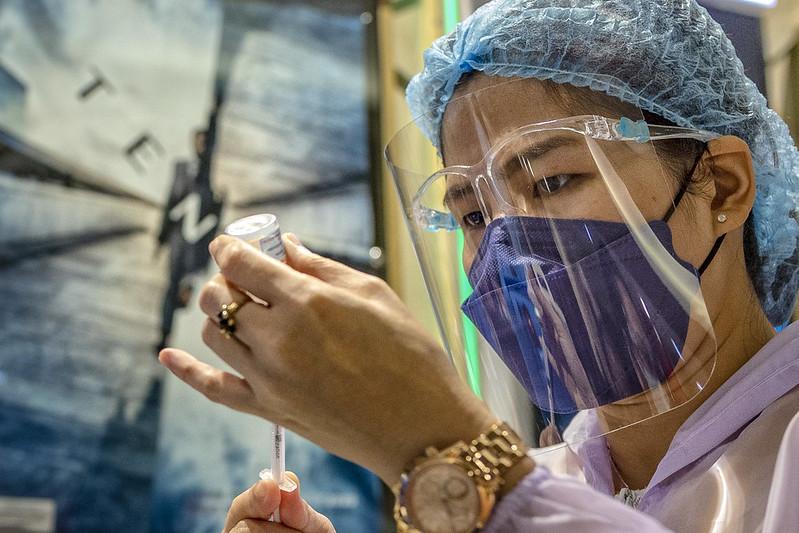COVID-19 activity in the United States last week showed more signs of declines, though deaths were up, and the World Health Organization's (WHO's) monthly snapshot of global activity suggests decreased activity, though the group cautioned that few countries are reporting data.
Most US markers down
Of the two main severity indicators, hospitalizations last week declined by 0.2%, with some counties in the moderate range—especially in Montana—and a few counties listed as high, mainly in the central part of the country, the Centers for Disease Control and Prevention (CDC) said in its weekly data updates.
Deaths rose 12.5% compared to the week before, with the percentage of deaths from COVID highest in North Carolina, at 4%, compared to 2.7% for the nation as a whole.
Early indicators also declined. Emergency department visits dropped 4.6% compared to the week before, and New Mexico is the only state currently at the moderate level. Test positivity last week declined by 0.7% and is at 8.7% nationally, with levels higher in the Southwest and Midwest than in the rest of the United States.
HV.1 variant edges ahead of EG.5 in the US
In its updated variant proportion estimates today, the CDC said the HV.1 Omicron subvariant—which descends from EG.5.1—increased to 25.2%, with the EG.5 level at 21.9%. Meanwhile, FL.1.5.1 held steady at about 12%, while the proportion of HK.3, another descendant of EG.5.1, rose from 4.1% to 7.5% over the past 2 weeks.
At the regional level, variant proportions weren’t listed for the south-central states and other areas, but levels of HV.1 were similar for all the regions that reported.
Global declines, but picture incomplete
Over the past 28 days, cases have declined 42% worldwide, with deaths down 43%, the WHO said today in its monthly update. It emphasized, however, that only 93 countries reported cases and 38 reported deaths. The agency added that trends should be interpreted with caution because of reporting delays and reduced testing and sequencing.
Some countries continue to report high burdens, including rises in hospitalization and deaths, which the WHO said may be more reliable indicators.
That being said, cases rose slightly in two WHO regions, Europe and Southeast Asia. Deaths were up in the Eastern Mediterranean region, as well as Southeast Asia, mainly due to retrospective reporting from India.
Of 29 countries that regularly report hospitalization data, 16 reported rises of 20% or more over the past month, with the five biggest increases from Saint Lucia, Chile, Bolivia, Slovakia, and the Czech Republic. And of 22 countries that regularly report intensive care unit (ICU) admissions, 13 noted increases of 20% or more, with the highest gains in Brazil.
The WHO added that the proportion of hospitalized COVID patients who have needed ICU admission has been decreasing since July 2021, when the ratio was 0.25. The level has declined to around 0.05 since the beginning of 2023.
Deaths in patients hospitalized for COVID have shown a similar drop since July 2021. "This is an encouraging trend indicating a lower mortality risk among hospitalized individuals," the WHO said.
EG.5 most common globally, though shifts continue
The WHO said EG.5 is still the most common variant of interest, with a proportion that continues to rise, including its descendant lineages HK.5 and HV.1
The agency said it has removed BA.2.75 from its variant under monitoring list, owing to low prevalence. And it replaced CH.1.1 on the list with its descendant DV.7, which is showing a slow rise in global prevalence.
BA.2.86, which scientists have been closely watching because of its high number of mutations, also showed a slight increase over the past month, the WHO said. Variant trackers have been monitoring the spread of BA.2.86 variants with even more mutations, especially JN.1.
Eric Topol, MD, director of the Scripps Research Translational Institute, in a "Ground Truths" Substack blog post, summarized the latest variant evolution developments, noting that the JN.1 L455S mutation has concerning immune-evasion properties. He also pointed to some models showing growth advantage in some countries, including France and to a lesser degree England.
Topol said it won’t be clear for weeks whether JN.1 will drive a rise in COVID activity or how well protection will be from previous immunity and updated COVID vaccines. Until then, getting an updated COVID vaccine is a good idea, regardless, he said, and nonpharmacologic interventions work against all variants and a range of respiratory viruses.
"The main message here is that concerning variants keep cropping up and there's a new path for the virus to find its way—versions that are getting further away from where this all started nearly 4 years ago," Topol wrote.




















